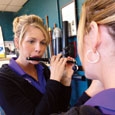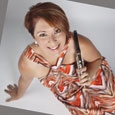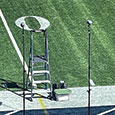My journey to becoming a piccolo specialist began in college and quite by accident. Although I had studied flute formally since I began playing at age 11, I was completely self-taught on the piccolo. As a result, my approach was simply to think of it as a small flute and not as a completely different instrument. Although there are differences between the two, this methodology was in retrospect psychologically very helpful because it eliminated the idea of unknown variables and allowed me to focus on the similarities. In my experience as a player and teacher, this mindset helps to foster confidence, a necessity for successful piccolo playing.
All of my students are required to do some study on piccolo to become comfortable with the instrument. When teaching piccolo to students, I begin by asking them to play a comfortable middle register note on flute with the best tone quality possible. Then, I immediately have them switch to the piccolo and play the same sounding pitch and try to match the tone to that of the flute. Of course, there will be some differences because the flute is cylindrical while the piccolo is conical, and the flute is made of metal while piccolos are often wood or some composite material.
The point of the exercise is to try to make the two instruments sound as alike as possible, achieving a solid, centered tone with depth and color in the sound. After all, the piccolo is really an extension of the flute’s range and completely overlaps the sounding range of the flute in its first two octaves. It is the piccolo’s lowest octave, however, that emulates the flute tone and color palette the most, and it is for this reason that my initial exercises focus on the low register of the piccolo. Just as on the flute, I find that once a player has the low register with a consistently focused and beautiful sound, the upper octaves are much easier to master.
The piccolo acts like a magnifying glass. All actions are much more acute on piccolo than on flute, and any problems that occur on piccolo are simply amplifications of issues that almost always also exist on the flute but that are perhaps not as easily discerned. For this reason, I rarely teach piccolo without the student having their flute nearby. I also feel that using the ear is critical in learning to play the piccolo well.
A mirror is another important tool to observe the subtle differences that exist between flute and piccolo embouchures. With this in mind, I first ask students to do the previous exercise without the aid of the mirror to develop critical listening skills. Once the desired tone is achieved, I have them repeat the exercise while closely viewing the embouchure and making note of any changes that are made. In this way, students avoid any preconceived notions about what the changes will be and can evaluate the differences they see once the desired tone is achieved.
Of course, I do guide them through the process, offering what information I feel is helpful for each individual student. For example, the embouchure hole on a piccolo is smaller than that on a flute, so for many players, setting the piccolo slightly higher on the lip helps to focus the airstream into the piccolo better. Because the embouchure hole is smaller, the aperture, likewise, must also be smaller than on the flute. When making this point, however, there are certain words that are taboo in my studio that neither I nor my students are allowed to use. I never describe embouchures with the words tight, pinched, stretch, pull, and tense or tension. These terms can have negative connotations. Instead, I use adjectives such as firm, small, round and well-supported when working to achieve the optimal piccolo tone and embouchure. Additionally, I teach the concept of a very forward embouchure to help students avoid pulling their corners back too tightly. I suggest students keep the cheeks relaxed and the oral cavity as open as possible while maintaining the focus at the front of the embouchure rather than in other places in the face. These physical concepts are also reinforced through the use of a mirror so students can see that their face is not tense in places where it should not be.
Players often forget that we have two planes on which we can control the angle of the instrument: the vertical plane is the most common, moving the instrument up and down (higher or lower). It is on this plane that we must make sure that the angle of the piccolo is parallel to that of the aperture. The second plane, horizontal, is often overlooked: adjusting the instrument’s position forward (i.e. pushing the right hand away from the body) or backward in relation to the lips. I have students stand directly in front of the mirror and slowly make changes in both planes of motion until they hear the optimal sound and focus in the tone. The visual element helps the student to reinforce the muscle memory so the correct position can be quickly repeated.
Finally, when first working with students on piccolo, I will often ask them to play everything full-bodied for many weeks – even months – before we begin to work to develop dynamic flexibility on the instrument. My reason for this is that I want them to develop a consistently beautiful tone that they can then practice to control at all dynamic ranges without sacrificing the sound quality. If students are working on playing softly but only have developed a thin, pinched tone at a louder dynamic, the result will be a less desirable, uncharacteristic sound at the softer dynamic.
The piccolo is enough like the flute that approaching it from a similar mindset is a psychologically healthy starting point that reinforces concepts students already know from playing the flute. By thinking of the piccolo as a small flute, students will have more confidence and play the piccolo with authority and a well-developed tone. From this strong starting point, students can discover and master the differences between the two instruments over time.






